Article's Content
What if you saw that only a handful of people were searching for your type of software each month?
You probably would decide that SEO isn’t going to be part of your marketing strategy.
Zapier likely found themselves in that same situation five or more years ago when they saw only a few thousand people searching for “automation software.”
But instead of giving up on SEO, they have built an SEO moat that drives over 455k sessions per month and ranks on 287k keywords with just 100 listicles.

Yes, I said listicles.
These “best of” listicles drive over half of their blog traffic and rank on extremely difficult keywords across a ton of different industries.
From the best note-taking apps to the best URL shorteners, Zapier has a listicle ready for a curious searcher to consume.
And they have also figured out exactly how to turn those searchers into customers with the help of those listicles.
Here’s the breakdown of how they accomplished it:
- Driving sessions with listicles
- Converting listicle readers into users
- Using listicles to experiment
Want to Steal Zapiers Content Strategy? Download this checklist!
By downloading this resource, you’ll also start receiving a few emails per week on B2B growth and content marketing
Listicles drive 5+ million sessions
Zapier has invested heavily in these content-heavy “best of” listicles. As of right now, they are the most popular type of content on their blog.
They published one of their top-ranking listicles, “Best To-Do Lists,” all the way back in 2015 and have updated it regularly since then.
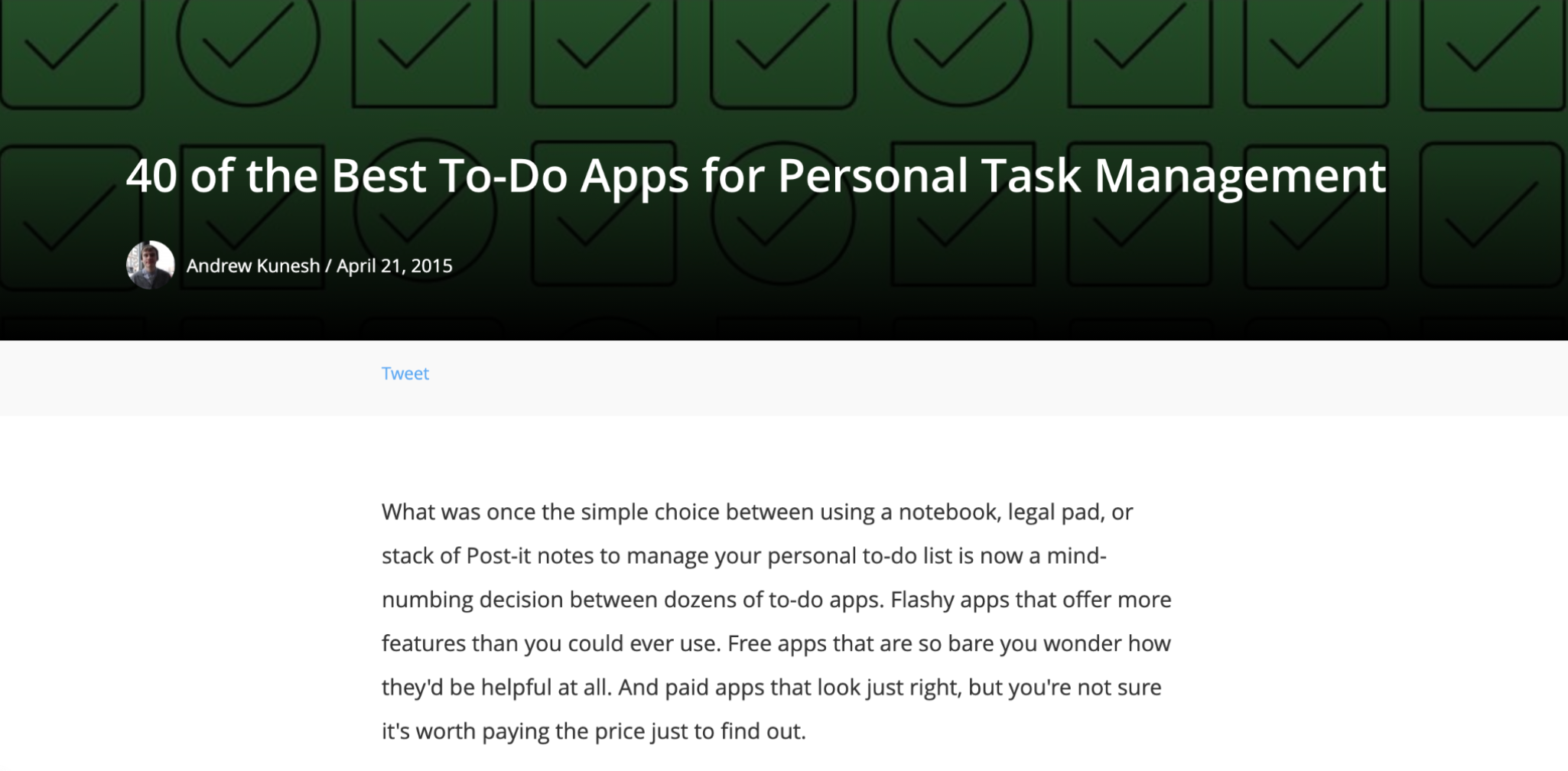
That longevity indicates that listicles are very important to their strategy. Since then, they have created listicles for the best note-taking app, the best presentation software, and more.
Each month these listicles drive around 455k sessions and rank on 287k keywords across the 100 different posts. This is a little over half of the traffic that the entire blog receives while ranking on only one-third as many keywords.
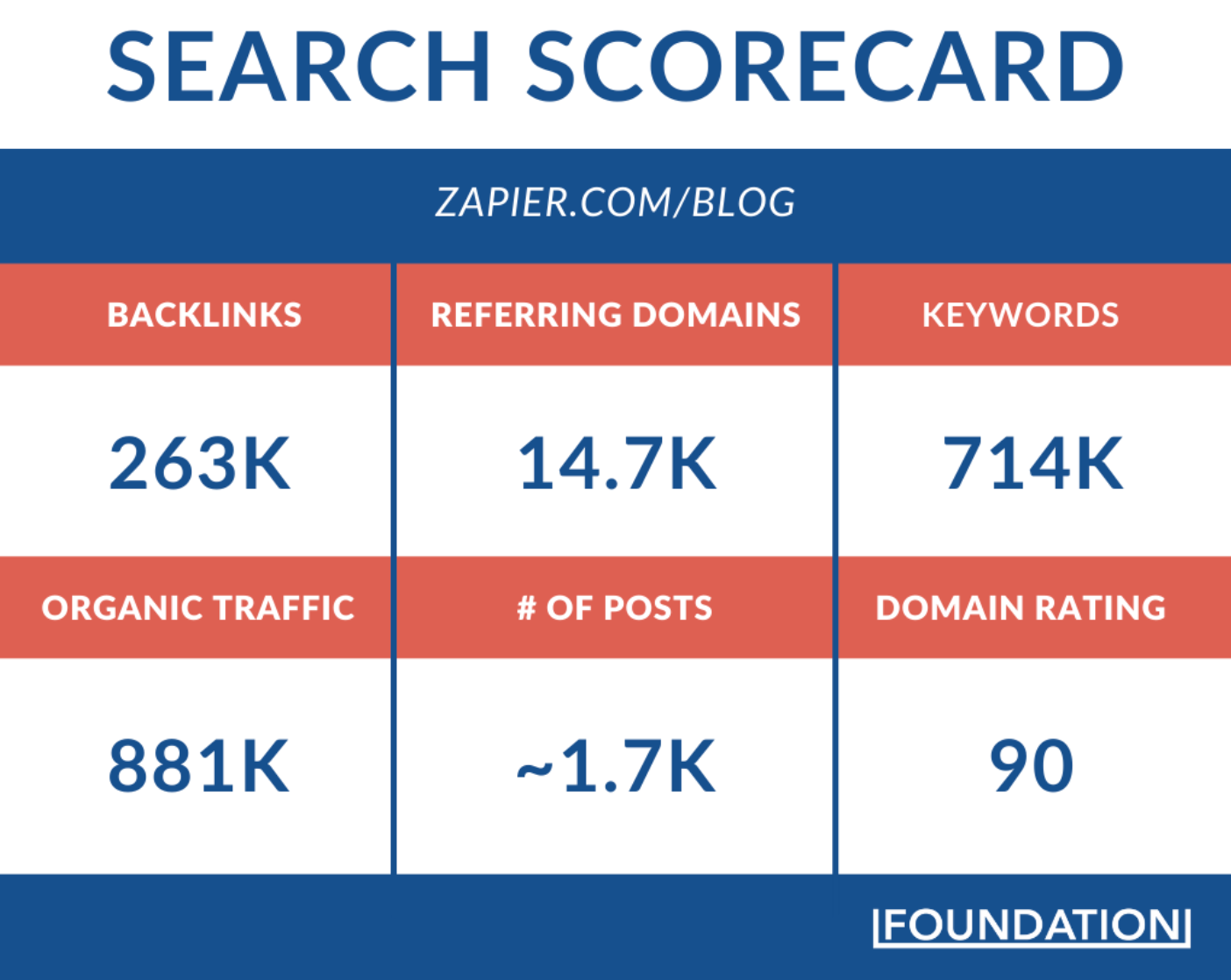
You guessed it, the five most trafficked pieces of content on their blog are all listicles:
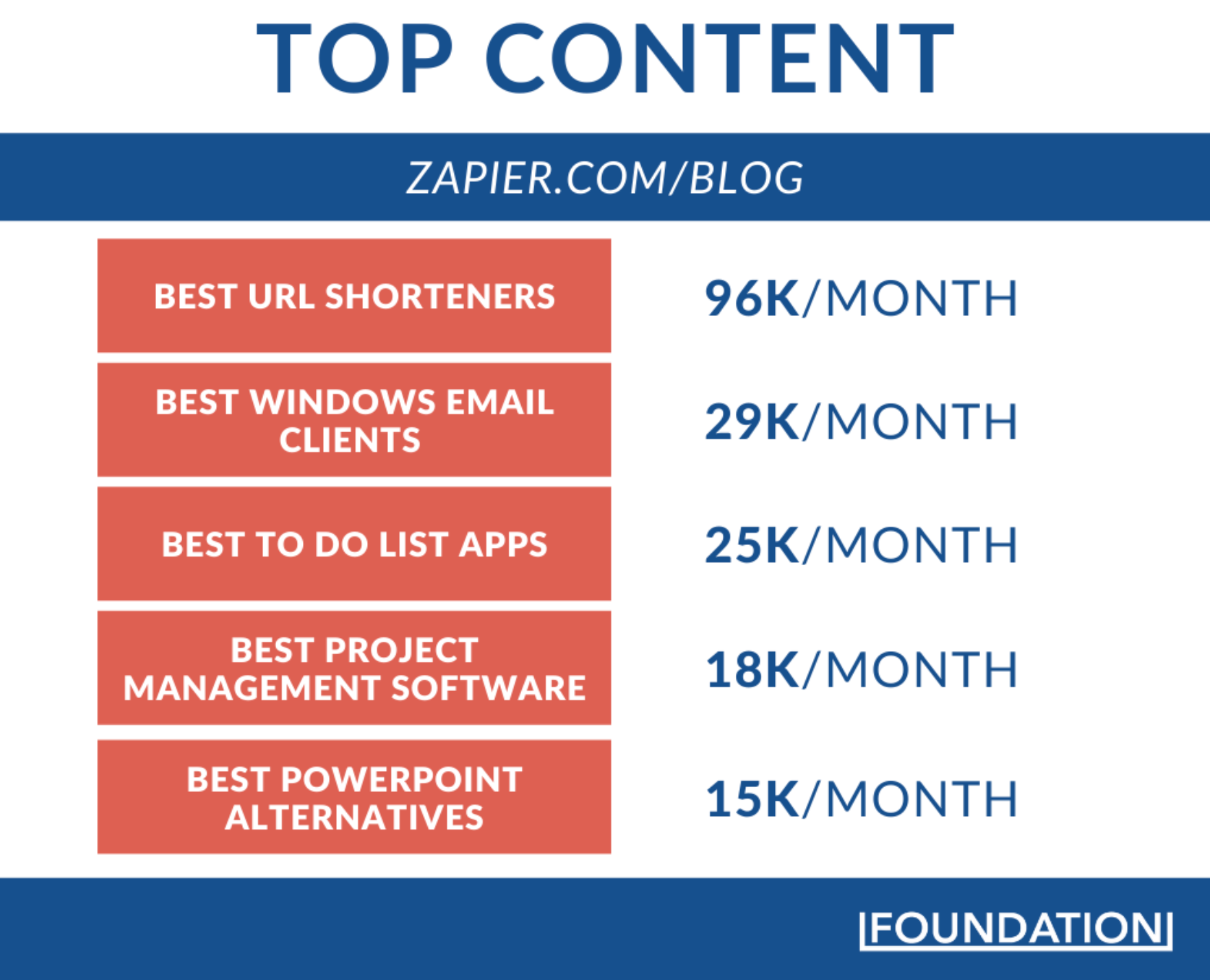
Those five listicles drive 183k sessions per month and can rank on around 39k keywords, which makes up about one-fifth the total organic traffic to the whole blog! Additionally, almost all of the top 50 most-trafficked posts on their blog follow the listicle format.
Now all of those metrics are super impressive.
But the true genius of these listicles is that Zapier has used them to rank on difficult and high-volume keywords that are not related to its core business. Like at all.
If you’re not aware, Zapier helps people automate simple tasks between apps. It’s a no-code automation tool.
Yet, Zapier ranks in the top spots for things like:
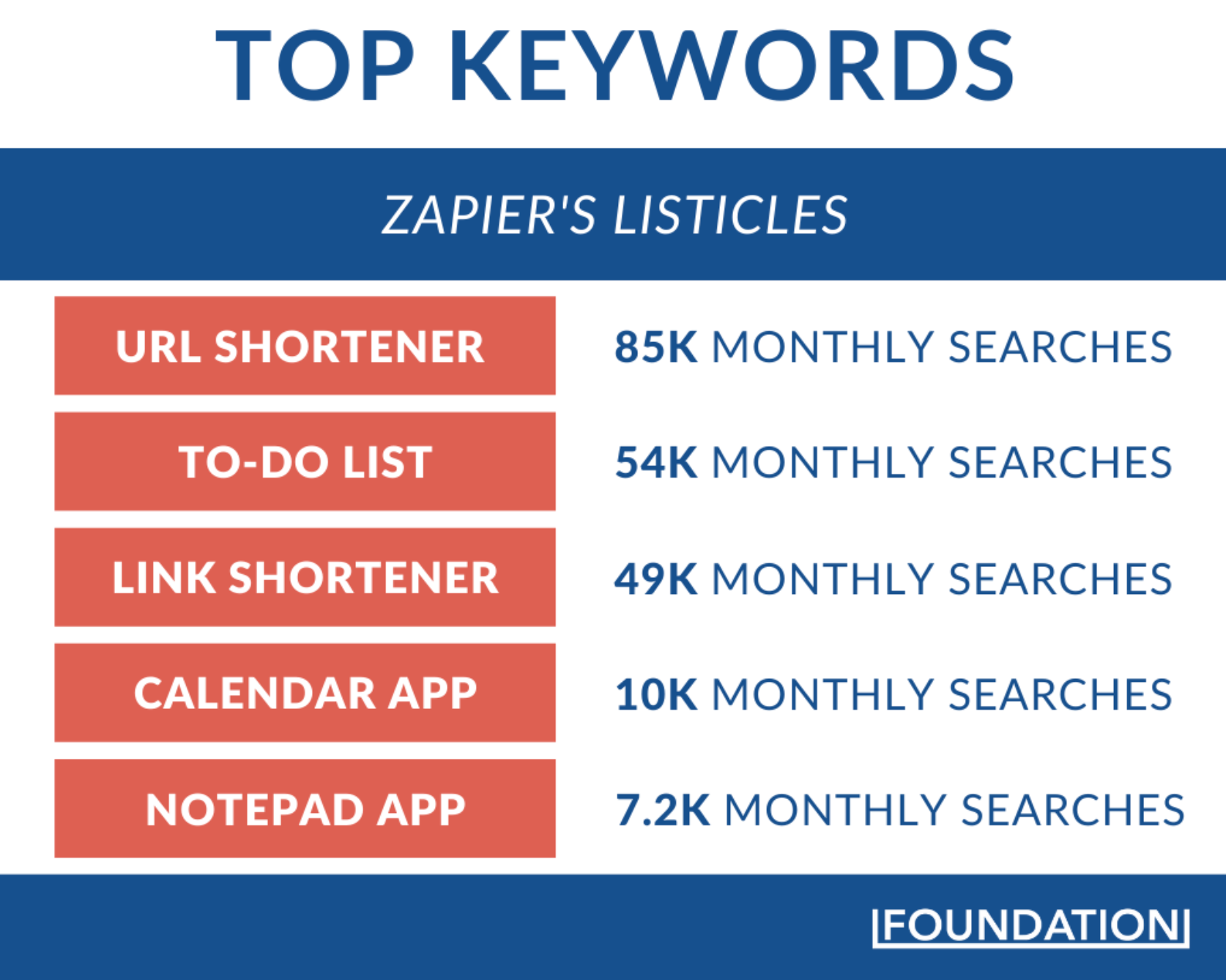
Last time I checked, they didn’t offer a To-Do List App or Notepad App, but they rank on these massive keywords with simple listicles.
Do you know what they do offer? Integrations and automation with all of those apps.
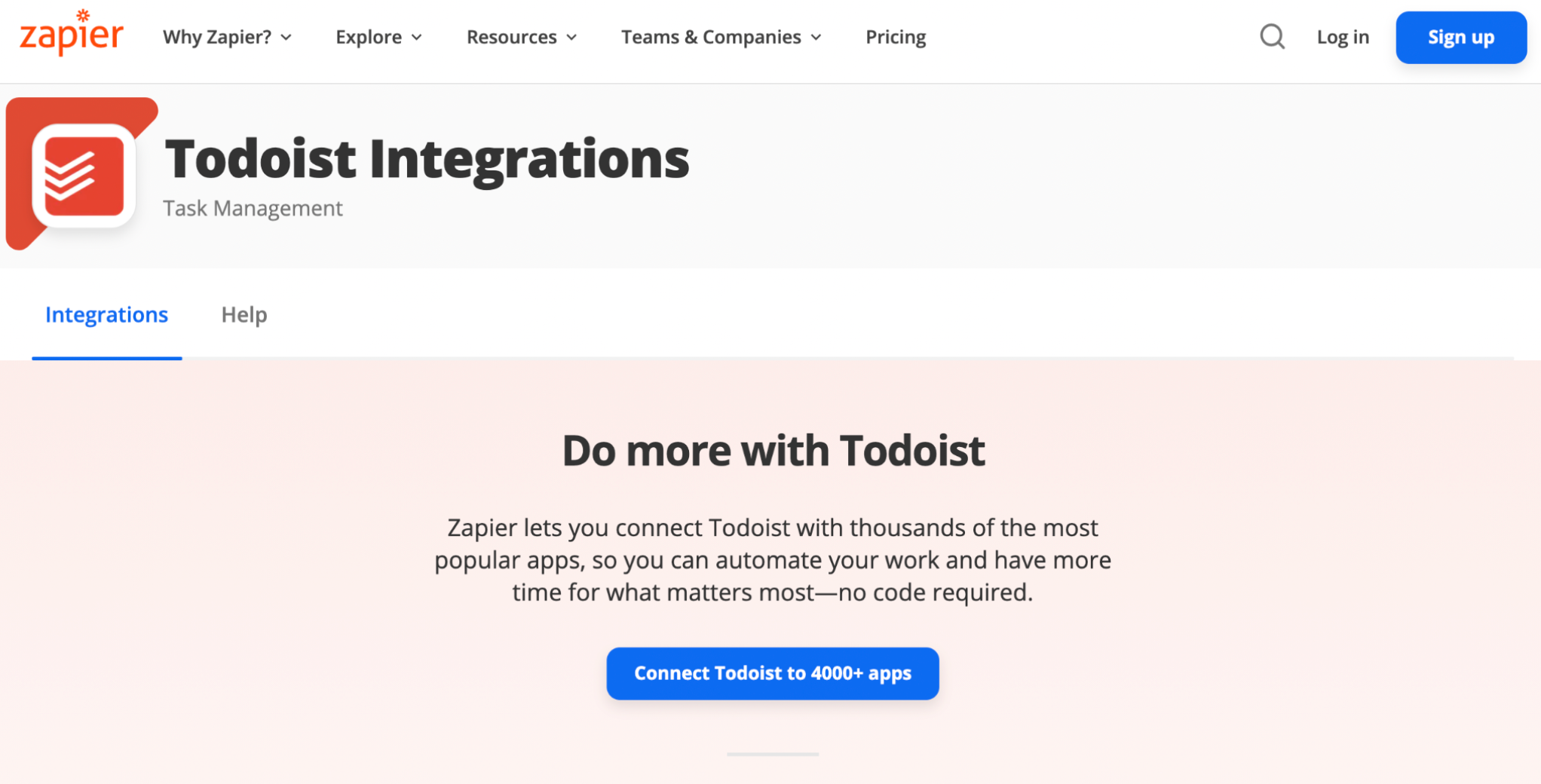
Not many people are searching for “automation software” but millions are looking for the best new apps each month.
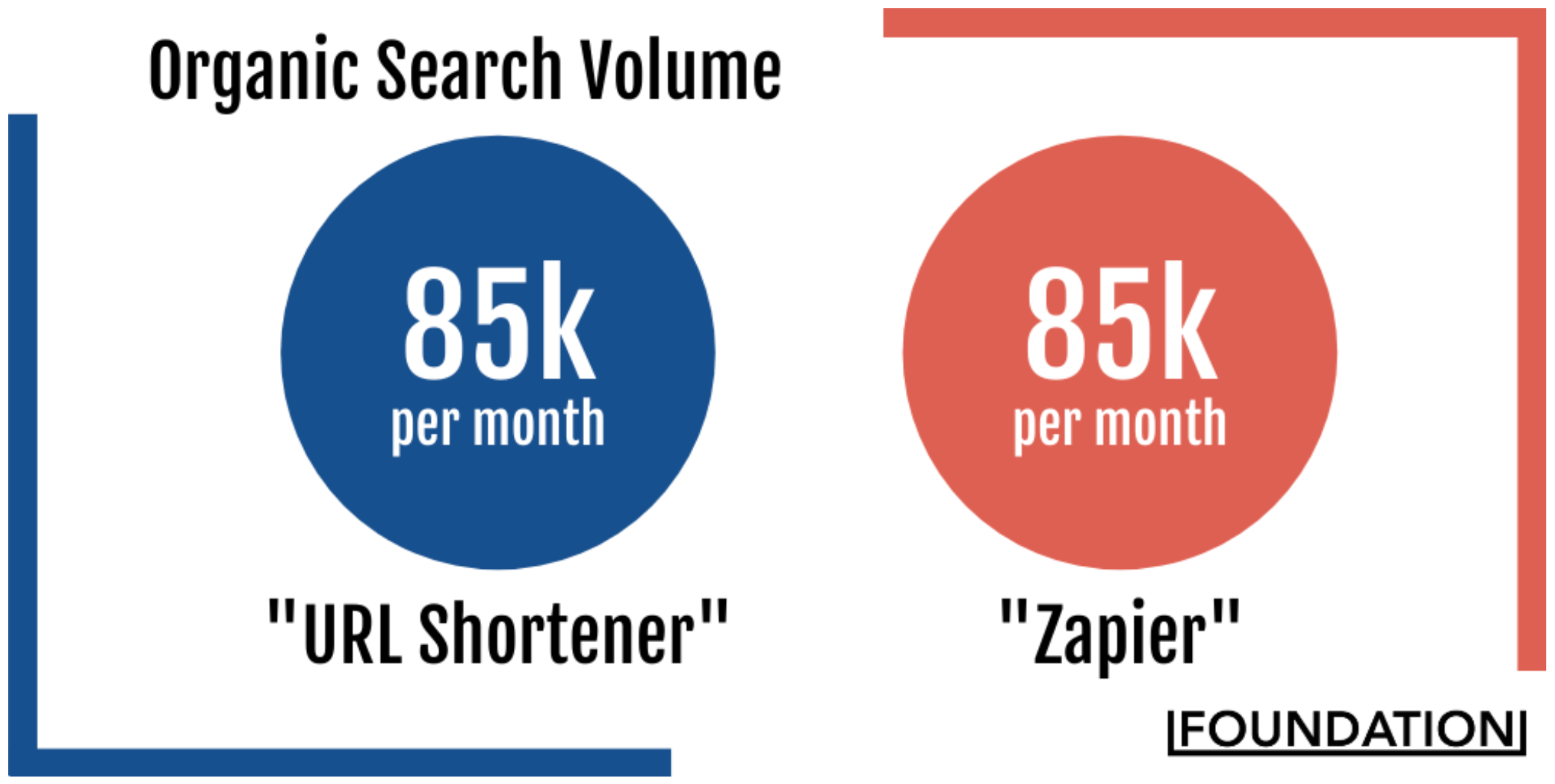
In fact, Zapier’s brand name only gets about 85k searches per month. By targeting a keyword like URL Shortener, Zapier can get in front of about the same number of people that are searching their brand name each month.
Their article on the best URL Shorteners drives almost 100k sessions a month and ranks on 9.5k keywords.
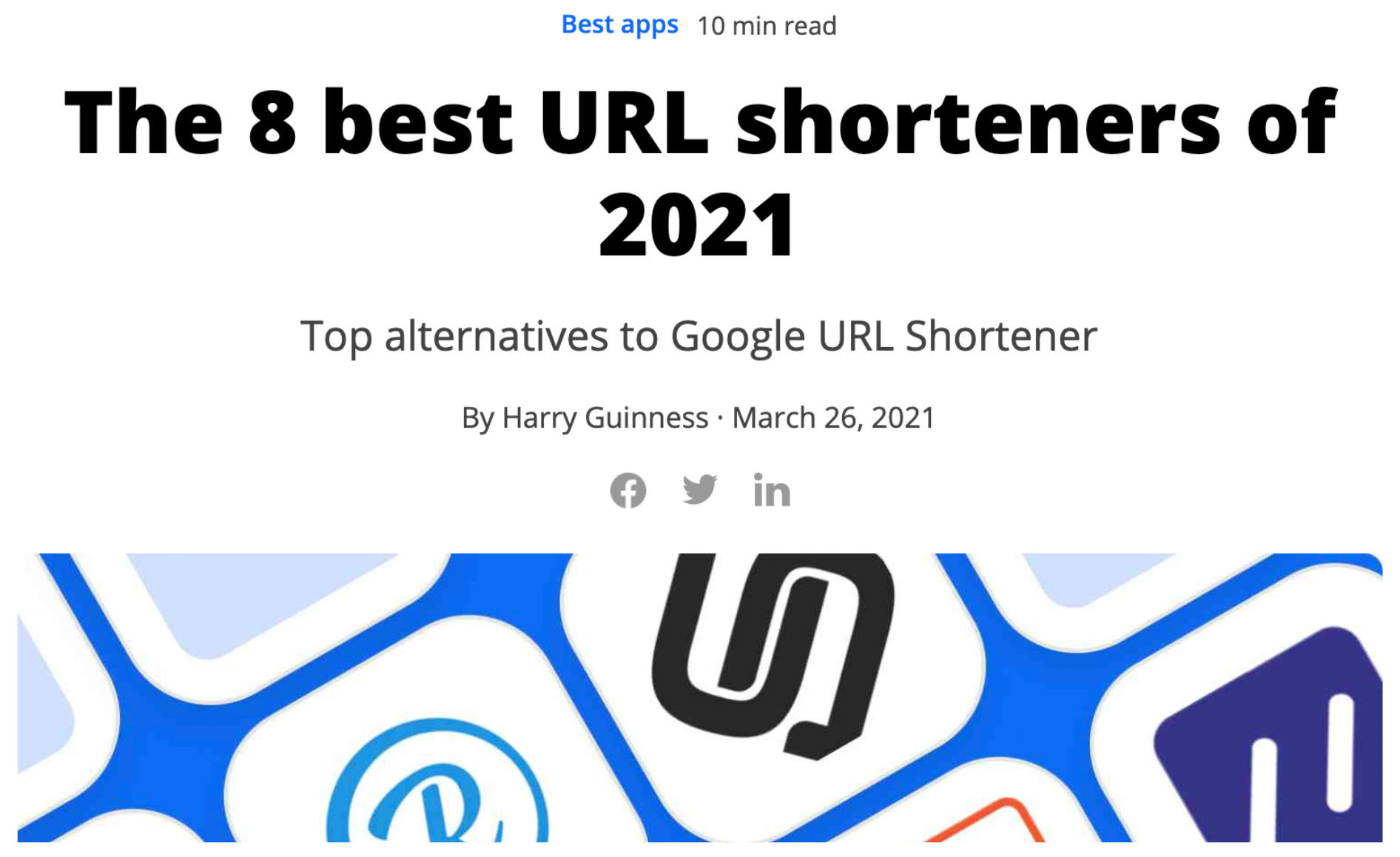
And that’s with only one article! There are hundreds of these listicles across different industries and niches.
Some people would call this strategy crazy, but it’s incredibly innovative. The marketers at Zapier have built an incredible content moat by simply listing the best presentation software, journaling apps, or time trackers.
Again, these apps are not directly related to its core business offering but they allow Zapier to dominate keywords and take advantage of curious searchers.
I mean, if you were searching for a new note-taking app, what would you likely click on:
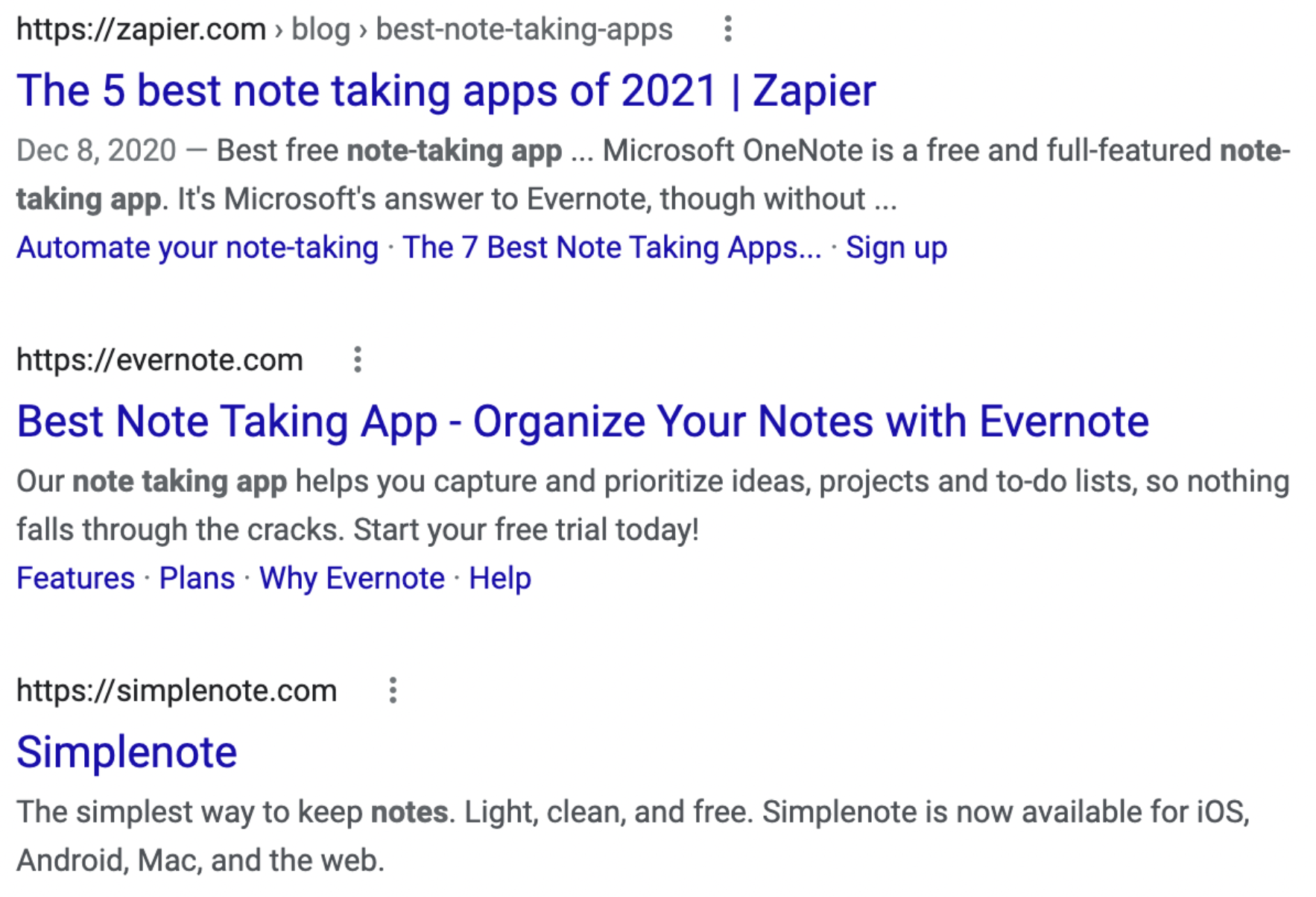
You would probably click on the listicle of the best note-taking apps, not the single apps that you may have never heard of. Zapier knows that it can convert those curious searchers into customers as well, but we are getting ahead of ourselves here.
Let’s use that article as an example to show how they basically can take over a whole content cluster with one “best of” listicle.
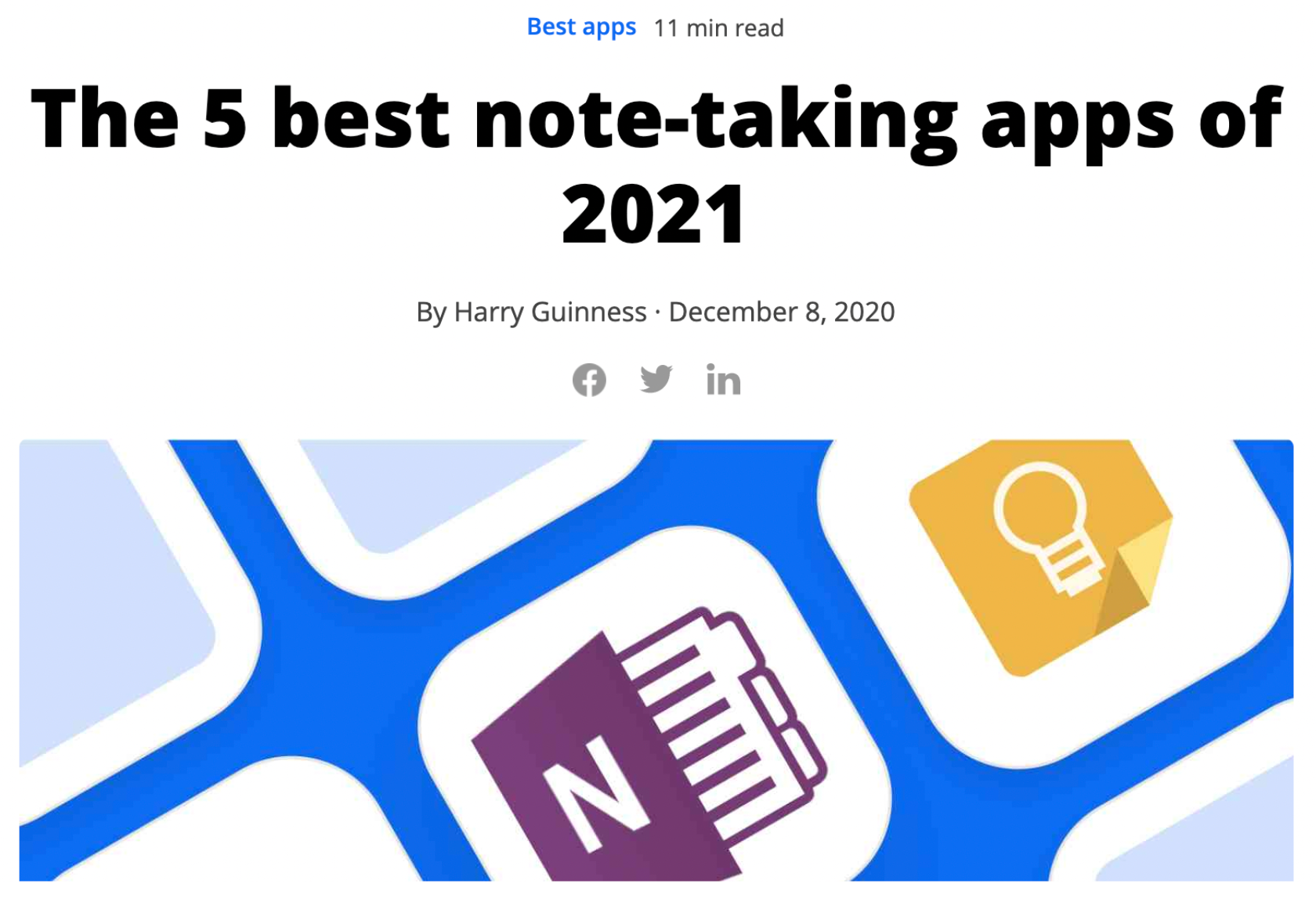
This simple listicle drives around 25k sessions back to Zapier’s blog each month and ranks on 10k+ keywords.
Does Zapier make a note-taking app? Nope.
Yet, they rank in the top spots for:
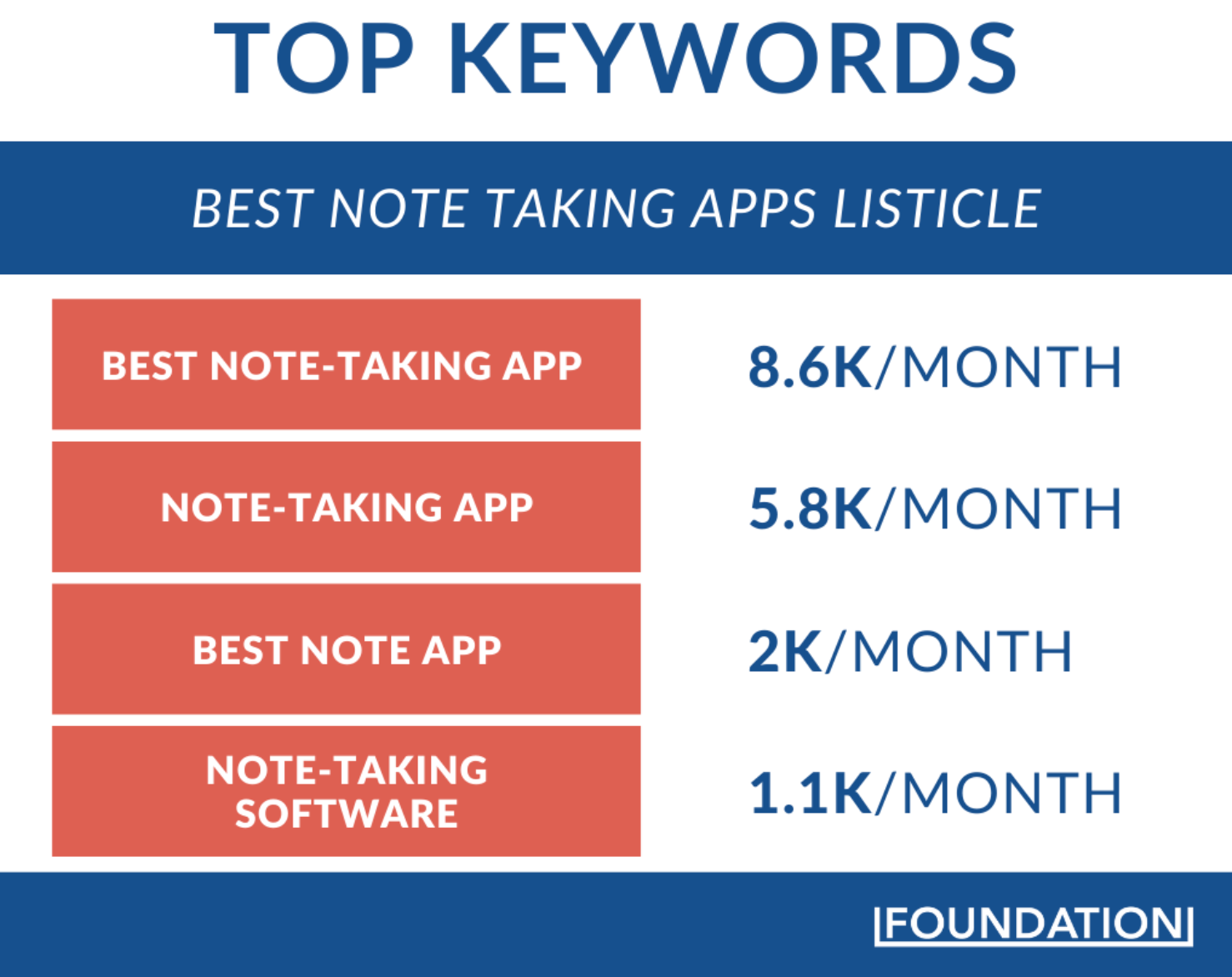
These aren’t easy keywords to rank on either; “note-taking app” has a keyword difficulty of 95! This simple listicle is able to outrank legitimate note-taking apps like Evernote and Simplenote.
That is incredible.
A lot of marketers would be happy with ranking on “best note-taking app” with their list of best note-taking apps. But Zapier can target both the parent keyword, “note-taking app,” and the child keyword, “best note-taking app.”
As well as almost every other long-tail “note taking app” keyword you can think of:

They even target branded searches like Microsoft Note, Onenote App, and more with this approach.
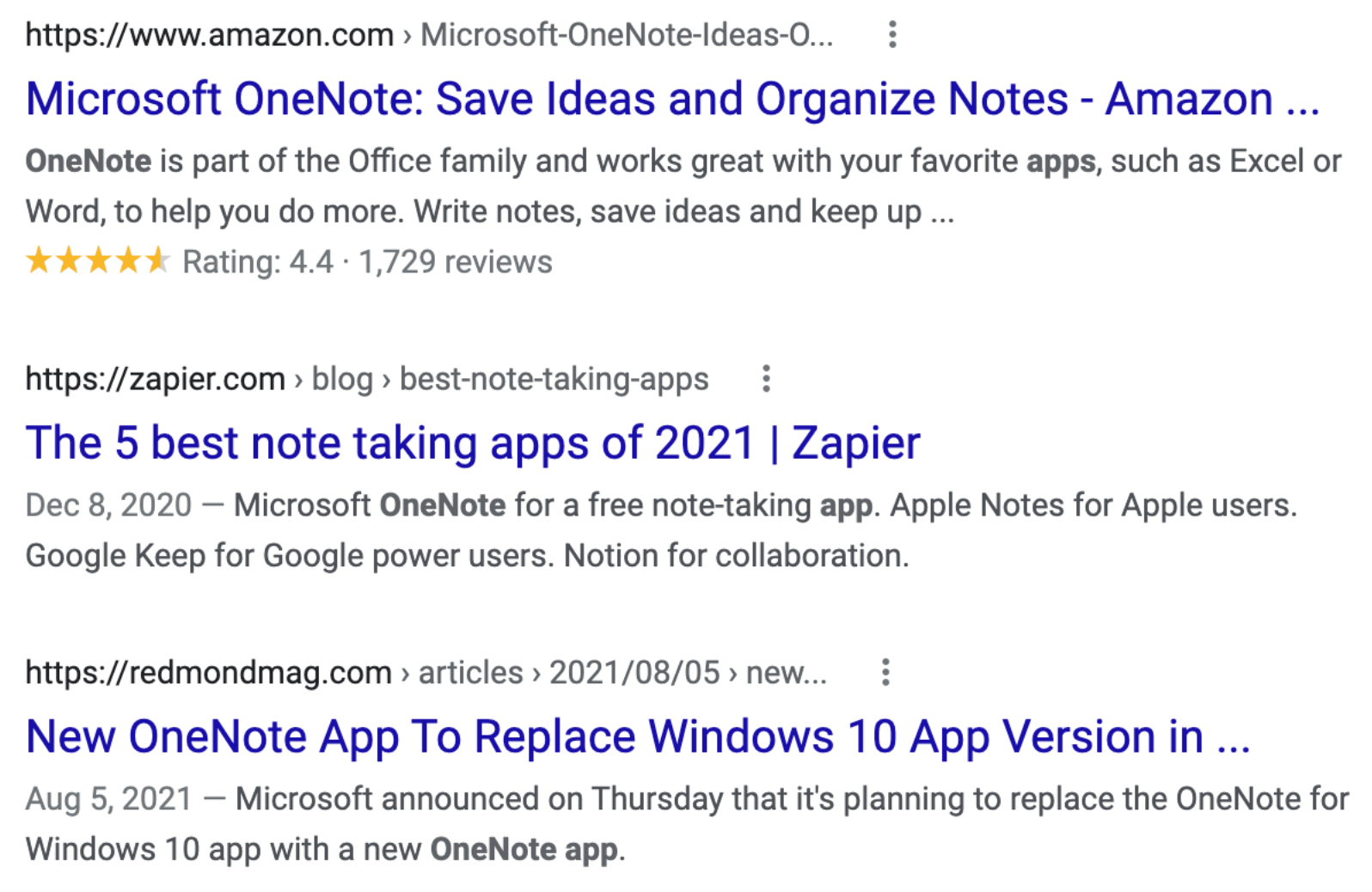
Hitting all of those different types of keywords is an impressive feat, especially on high-difficulty keywords like “note-taking apps.”
Yet they rank on thousands of other high-difficulty keywords from across the whole business spectrum.
Another great example of this keyword domination is the listicle that outlines the best presentation software:
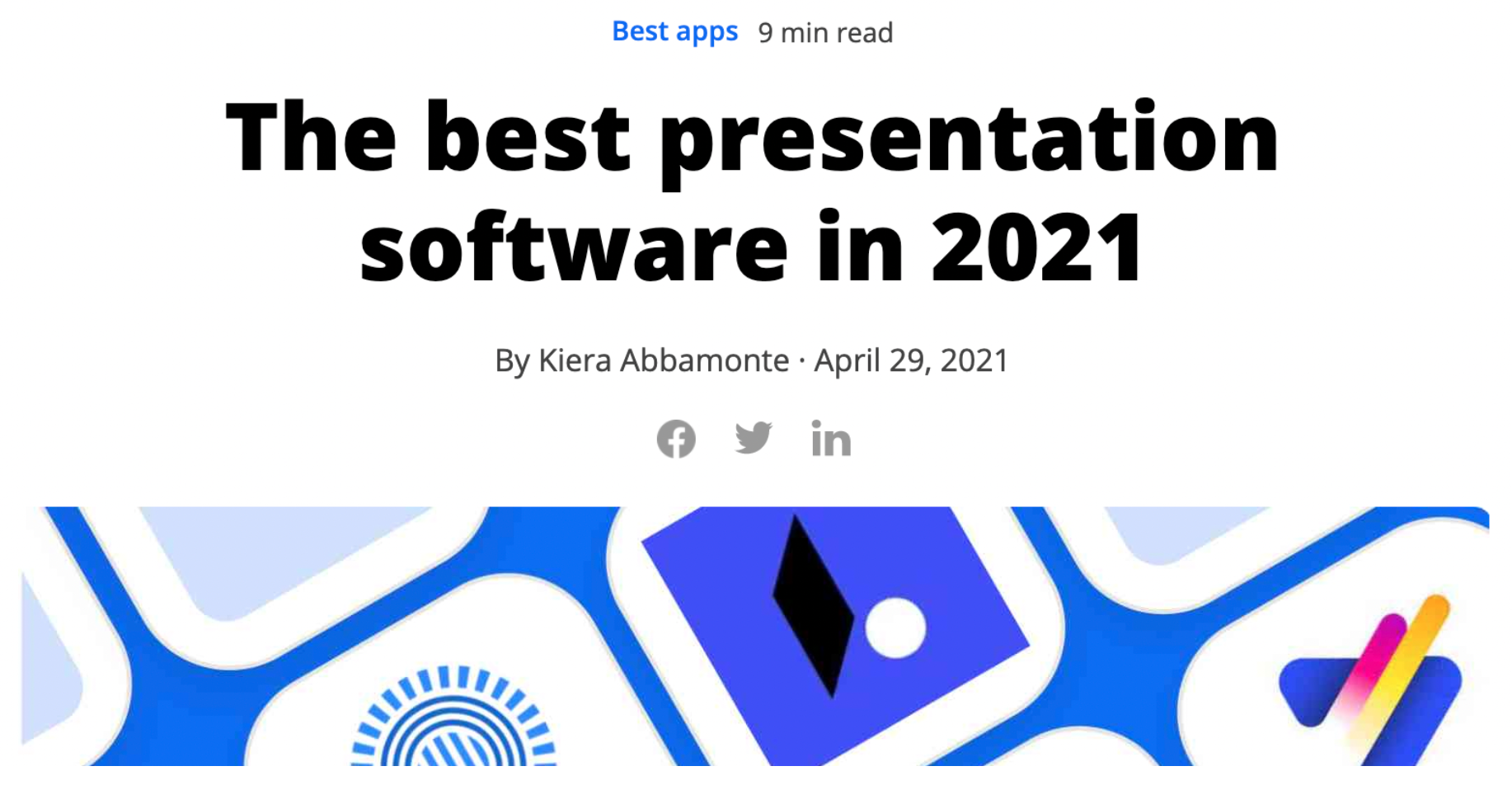
This listicle ranks on almost 10k keywords and drives 14.4k sessions per month back to Zapier.
With this single listicle, Zapier is capturing more traffic and keywords than they ever could by targeting “automation software” or a related keyword.
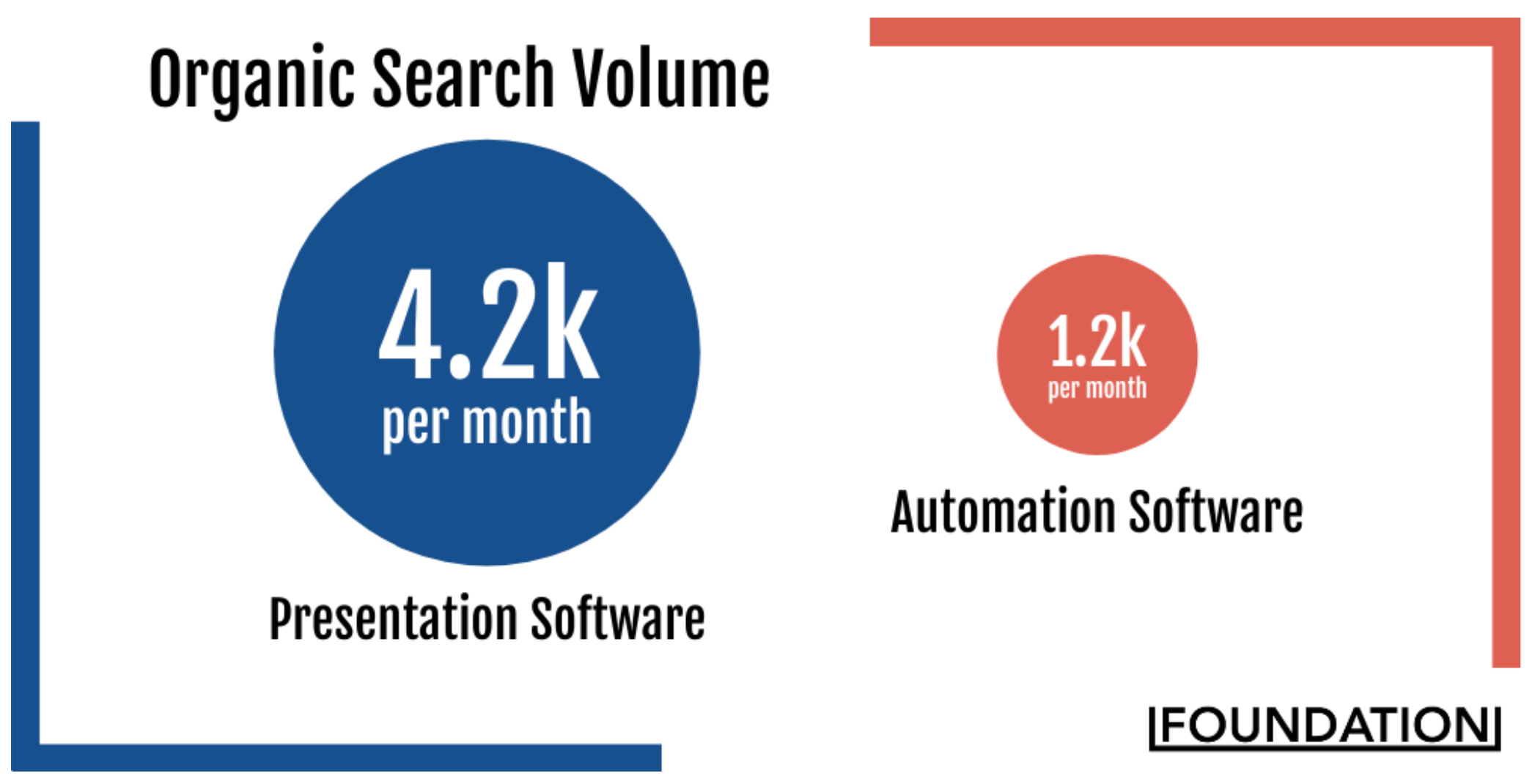
Zapier also has been able to get the featured snippet of “presentation software,” which gets about 4.2k searches per month, and rank in the first spot for “presentation app,” which has a keyword difficulty of 93.
With a listicle, they are outranking companies that legitimately make presentation software.
Again, Zapier hasn’t created ANY presentation software. but it’s still able to rank in the first few spots for all those keywords. Instead, they have created amazing content that Google, and users, see value in.
Now you could drive millions of people back to your blog like Zapier, but as a SAAS company, that means nothing if they don’t convert or sign up.
Thankfully, Zapier has optimized each of these listicles to drive conversions too.
How they convert listicle readers into users
It’s helpful to think about these listicles as the core of a content cluster when trying to understand Zapier’s content marketing strategy.
![]()
They aren’t just randomly publishing listicles hoping for views or shares, like Buzzfeed. This is a very strategic move to get their integrations, recipes, and “magic moments” in front of more people. At the right time of the buyer’s journey.
Let’s use the listicle about the best time tracking apps to explain that idea. Again, Zapier doesn’t make any time tracking apps, but they rank on 3.5k keywords and drive about 16k sessions per month.
![]()
That listicle ranks in the first spot for “time tracking app” which gets 3.1k searches/month, “tracking my time” which gets 2.8k searches/month and “timing app” which gets 2.8k searches/month.
They also rank on the first page for things like “timing apps,” “time tracking,” and other related keywords.
So it’s safe to say that this article is going to be seen by people looking for help tracking their time.
Most of these keywords would also be categorized as informational searches based on search intent. People are often looking for more information about a product or service, and they are very early in the buying process.
Listicles appeal directly to those people, and Zapier has positioned the content to be perfect for them.
For example, they have created a list of “best time tracking apps” to help them capture the featured snippet for a few main keywords.
![]()
People who are searching for something as vague as “timing apps” are going to be more than happy to click on the list of best timing apps to learn more.
![]()
The searchers may know they want to find an app to improve their time tracking, but have no idea what solutions are available.
This simple list is part of all the listicles that they produce, making it easy for them to capture thousands of featured snippets across the spectrum.
Zapier has also outlined what makes a “great” timing app in the first main section of the listicle:
![]()
This section, which is also in every other listicle, appeals directly to people who know they need a time tracking or timing app but need a lot more information before making a buying decision.
I believe this section helps legitimize Zapier as a reputable source of informationin the eyes of these searchers. Even if they have no idea what Zapier does, this section likely helps each reader trust the content they are about to consume.
Next, the writers at Zapier take a deep dive into what makes each of the products amazing and worthwhile to a user.
As you can see, each section is stuffed with long-tail keywords. Zapier has optimized every part of this content to help it rank high in search.

The EAT signals are strong throughout each section which shows Google that this content is super valuable, especially compared to the other content ranking for these keywords.
And finally, in each section, there is a phrase that shows how Zapier integrates with each app on the list, as well as two or more integrations Zapier has created for that app:
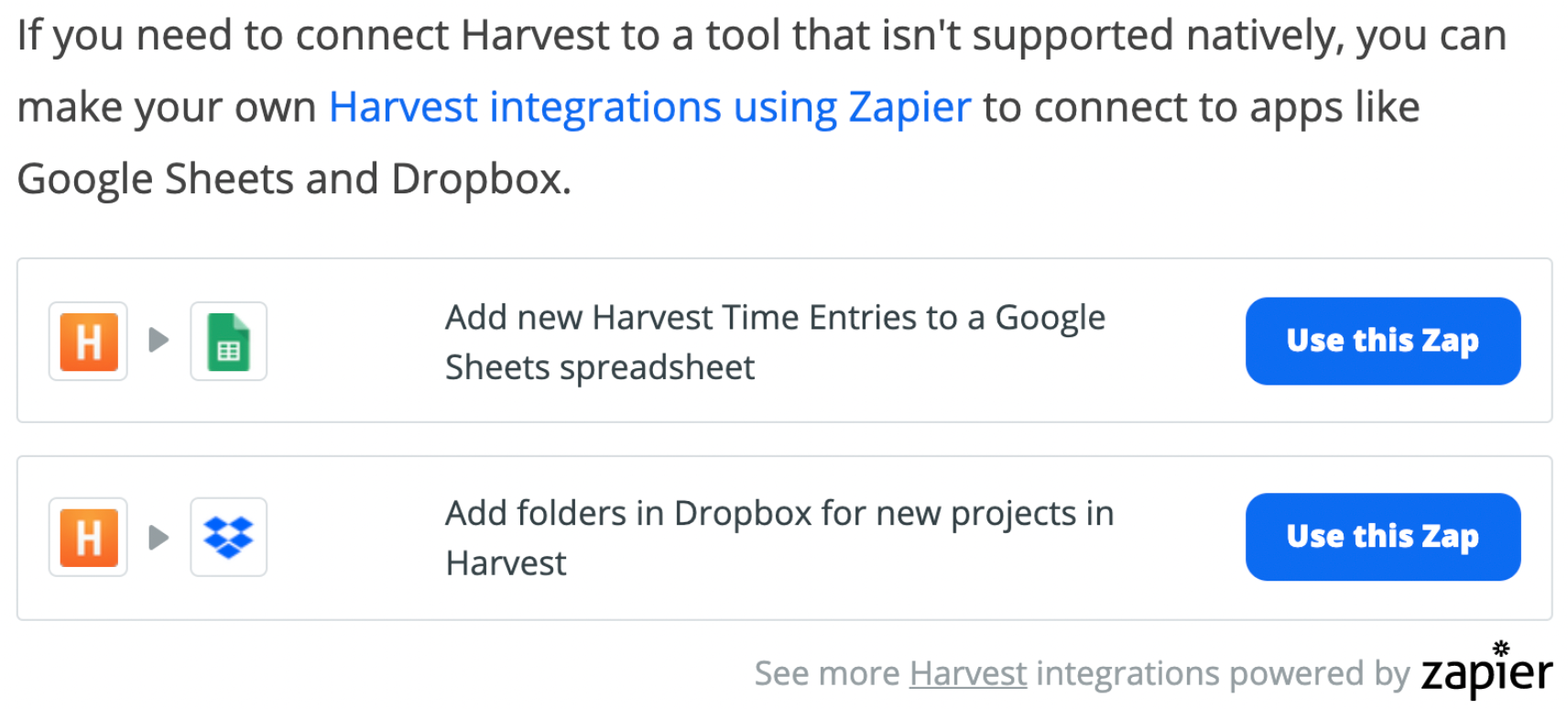
This simple addition to each section is how Zapier converts hundreds of thousands of readers into users. And, it’s the main reason they have invested so much into listicles.
Until this point, in almost all of the listicles, the content is very informative and doesn’t even mention Zapier.
This is very intentional; the creators of these listicles want to give the readers a ton of helpful information and show why each app is valuable before trying to convert them into users.
I feel like they want to sell someone on signing up for a new app, like Everhour, and then show how Zapier can help them take it to the next level.

They want to make a reader say “Wait, you can do that?!?” with the integrations and then push them into the sign-up funnel. And for a lot of these readers, it will be mind-blowing that they can link a new app with something they already use each day like Google Sheets or Airtable.
I mean when I learned that I could automate social shares with just a Google Sheet and Zapier, it changed the way I looked at social media.
Those “magic moments” are that powerful, especially when it comes to helping people improve their workflow, which Zapier does better than any other company.
Those Call to Action buttons on each integration lead to a simple but effective landing page:
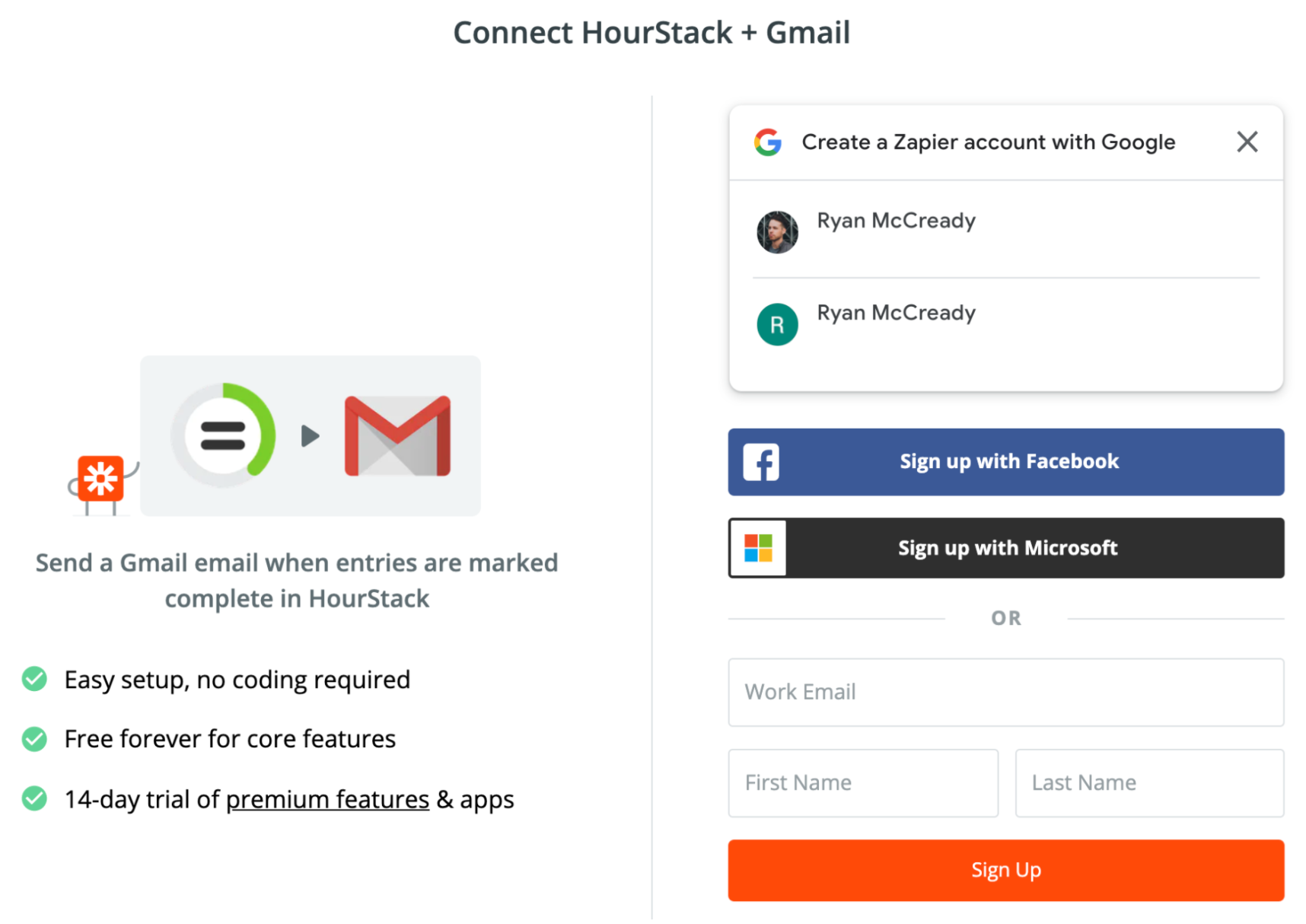
I’m a big fan of minimalist landing pages like this example because you give the user one path to success. They either sign up, or they don’t. There are no links to the blog or pricing pages that a new user could get lost on.
Additionally, Zapier can use this information to retarget a user with relevant ads if they don’t sign up at that moment.
If you want to check out all the integrations for each app, like Hourstack, all you have to do is click either of these links:
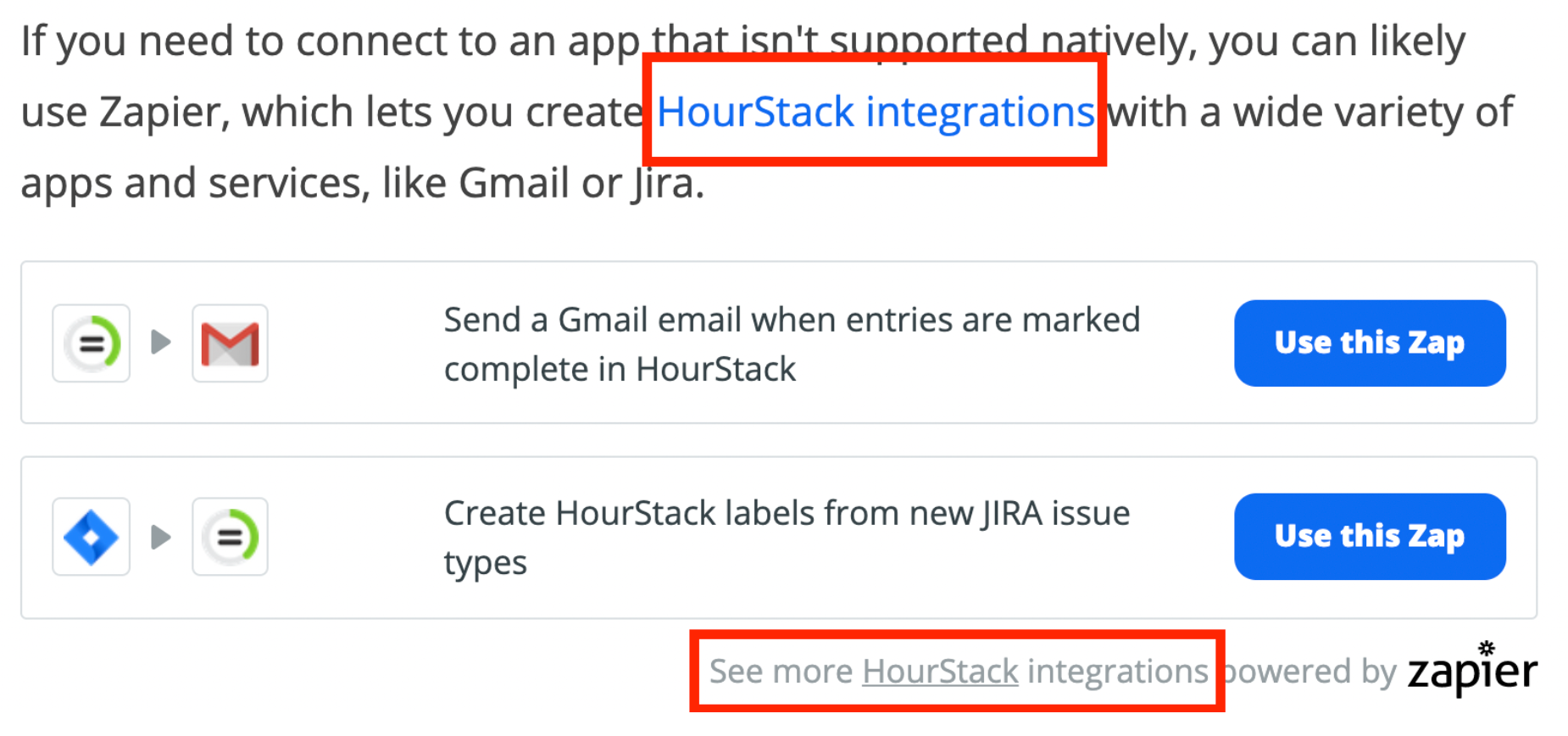
This type of landing page is a lot more content-heavy but I’m guessing it converts extremely well. They wouldn’t link to it twice in a highly optimized blog post if it didn’t drive sign-ups:
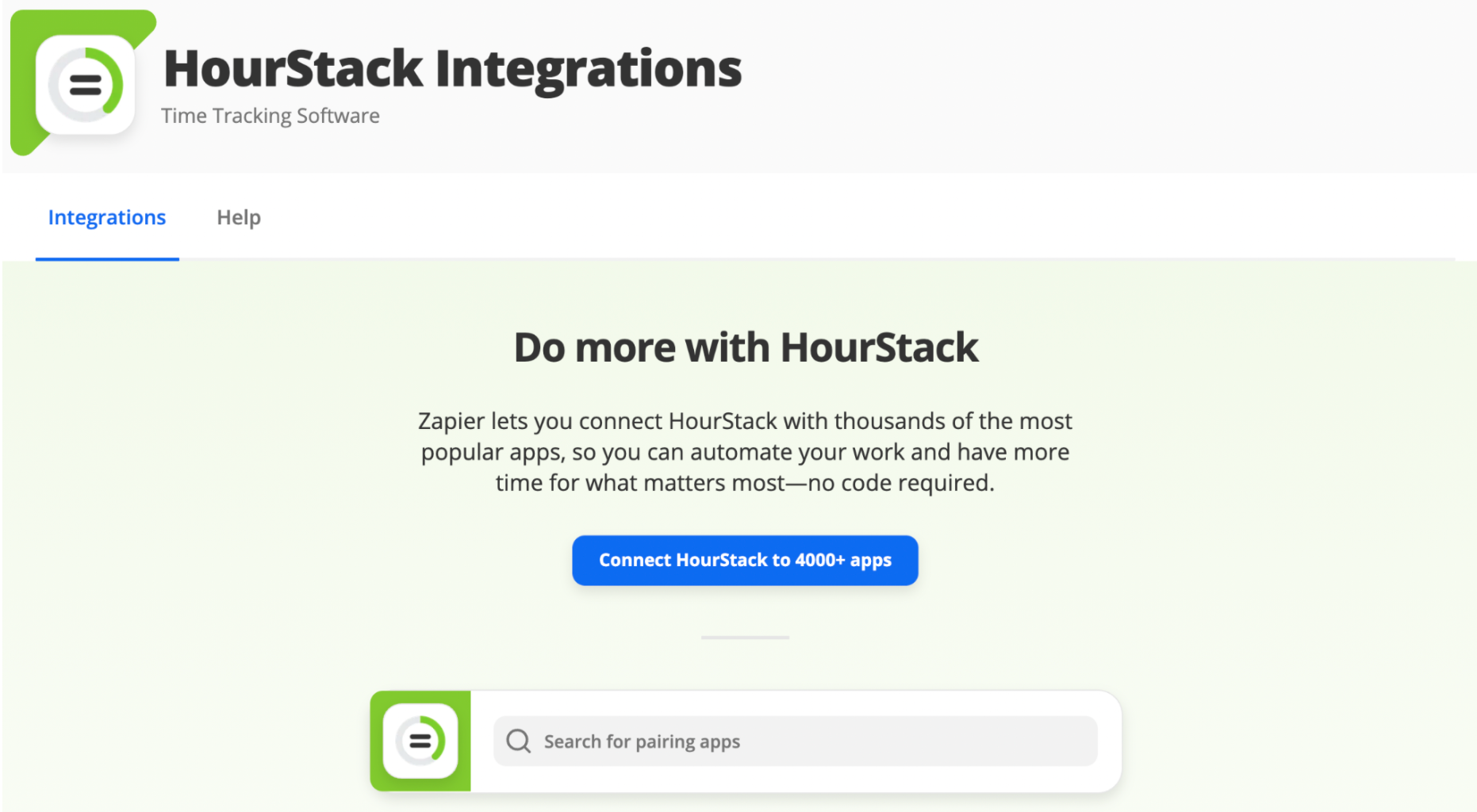
The huge problem with this landing page, and the thousands of other ones like it, is that they rank for almost no keywords.
These pages convert extremely well, but no one is going to find them on Google, which is why the listicles are so essential to their strategy.
![]()
Zapier has found that it’s much easier and more effective to rank on hundreds of thousands of keywords with these 100 or so listicles, instead of trying to get thousands of their integration pages or app landing pages to rank.
According to Ahrefs, there are about 35k pages on the /apps subdirectory, which is where the integration landing pages live. Those pages drive around 100k monthly sessions and rank on 200k keywords.
These numbers translate to about 3 organic page views per page on the /apps subdirectory. Not an inspiring metric.
I would take that modest estimate with a huge grain of salt. Almost all the keywords that those pages rank for are branded terms, like PandaDoc, that usually don’t drive much traffic back to non-branded sites.
But if we take that estimate at face value, the value of these listicles is even more apparent. The collection of listicles still drive 455k sessions per month and rank on 287k keywords.
Even though there is a full listicle in between a searcher landing on the integration or sign-up page, this approach is still very effective in the long run.
![]()
Even if a fraction of the searchers sign up for Zapier, it’s still more than they would EVER get targeting “automation software” or other related terms.
So do you now see why they would invest so much in a bunch of listicles? Good!
Want to Steal Zapiers Content Strategy? Download this checklist!
By downloading this resource, you’ll also start receiving a few emails per week on B2B growth and content marketing
Listicles can do so much more
Ranking on hundreds of thousands of keywords and driving conversions aren’t the only benefits these listicles provide Zapier.
Zapier can use these unique pieces of content to:
- Test the appetite of future integrations.
- Get an early foothold on a new keyword.
- Entice new apps to join the automation platform.
Let’s take a look at one of their most recent listicles that covers the best SEO keyword research tools, which seems fitting.
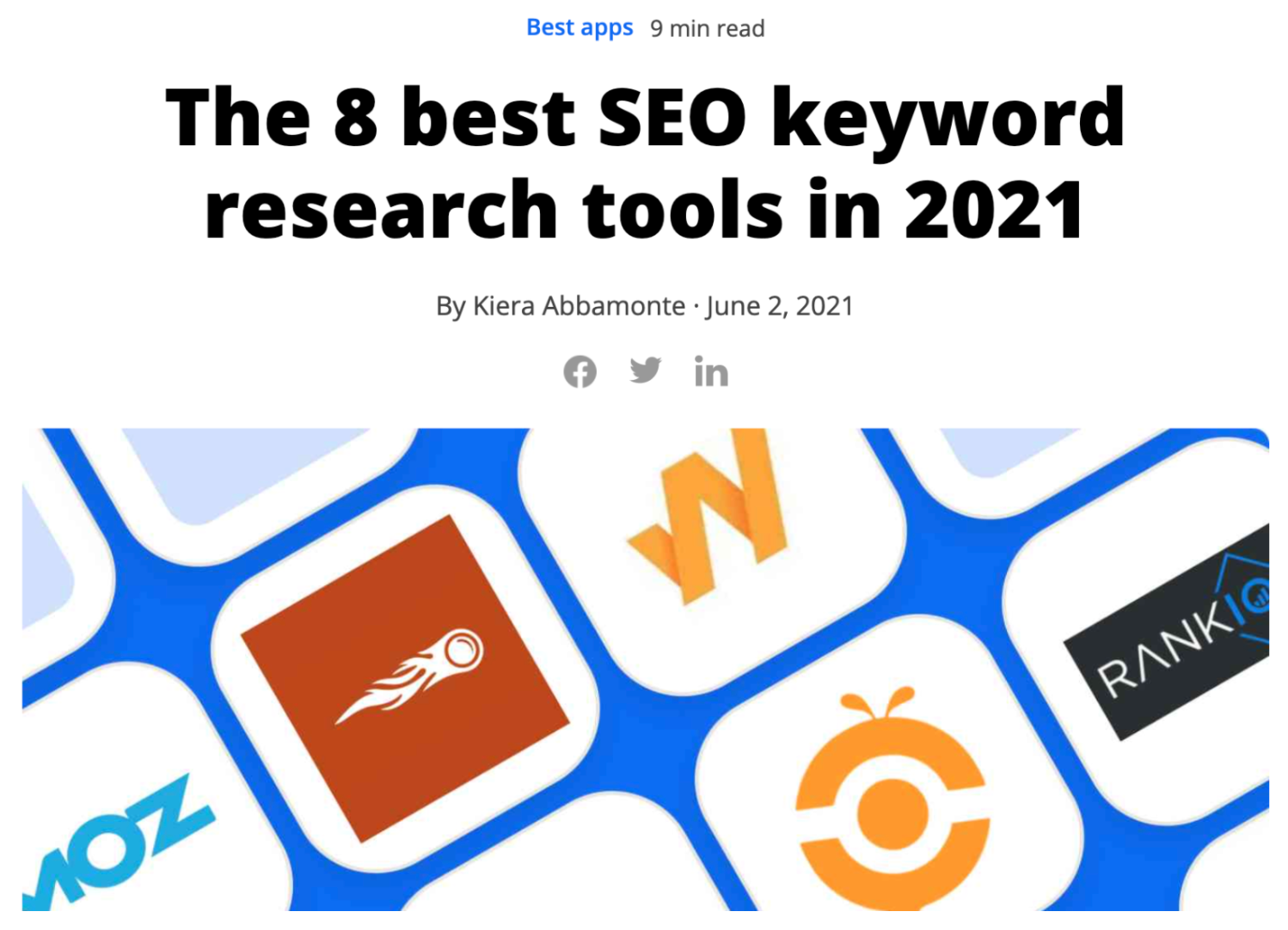
The team at Zapier published this listicle in June 2021, but it is already ranking on approximately 4k keywords and driving 1.6k sessions per month. As I am writing this, it’s mid-September, so this listicle has accomplished a lot in just a few short weeks!
It currently ranks for:
- keyword searching tools
- keyword research tools
- SEO keyword research tool
- best keyword research tools
All of those examples have a keyword difficulty of over 95, so that’s no small feat. Zapier has already grabbed the featured snippet as well.
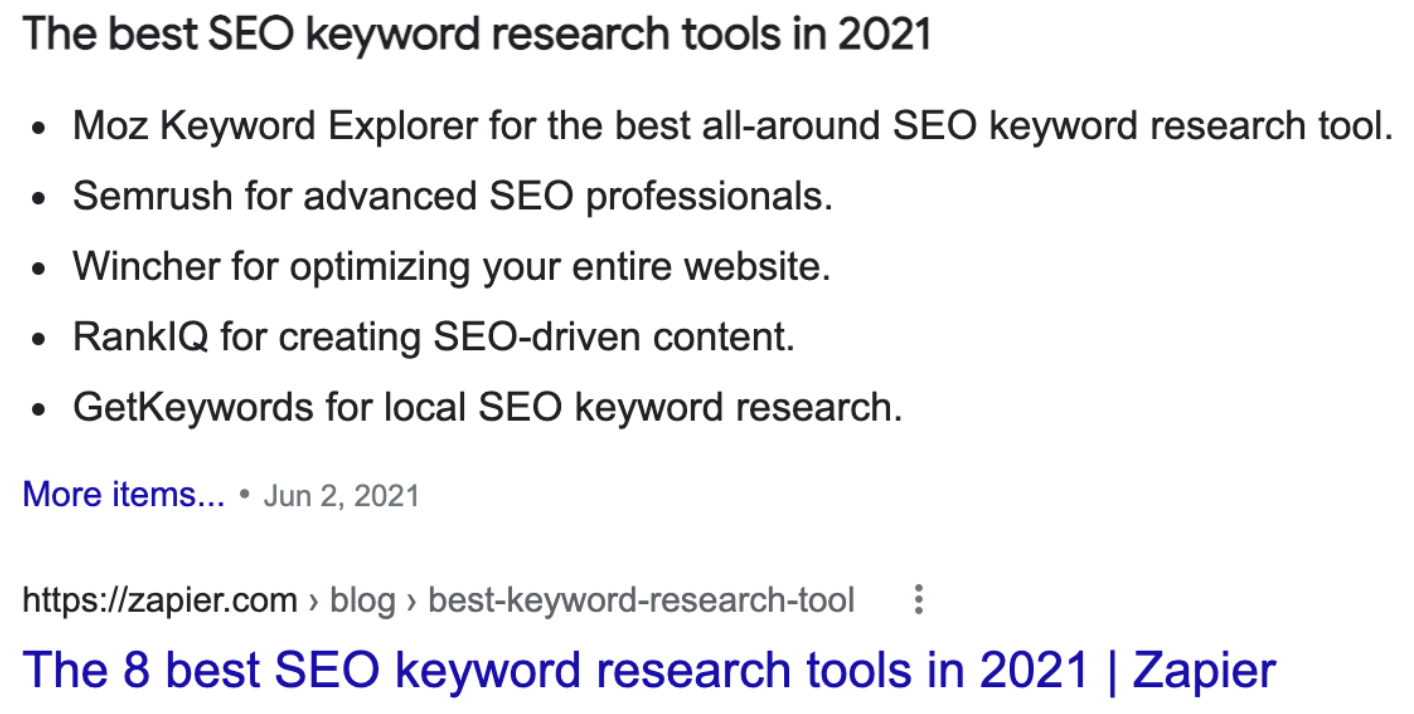
If you have made it this far in the article, you already know that Zapier can make their listicles basically rank at will.
That’s not the interesting part. The main difference between this listicle and some of the others is that there are no links to integrations or sign-up landing pages.

In any other listicle, there would be a list of integrations right above the pricing section, but there are none in this entire article.
There is a Call To Action to download an eBook, but that’s about it!

So why would they put out a listicle that drives no conversions? Wouldn’t that go against their entire strategy?
Nope! Rather, this listicle provides a very easy way for Zapier to test the appetite for integrations with these apps, before they build them out.
Zapier can determine if people are reading their listicle of SEO keyword research tools before having to build integrations with something like Moz or SEMRush.
If they drive a ton of traffic to this listicle, then Zapier knows they probably should move forward with building new integrations for each of the apps listed. If not, then they saved themselves a lot of unneeded development time.
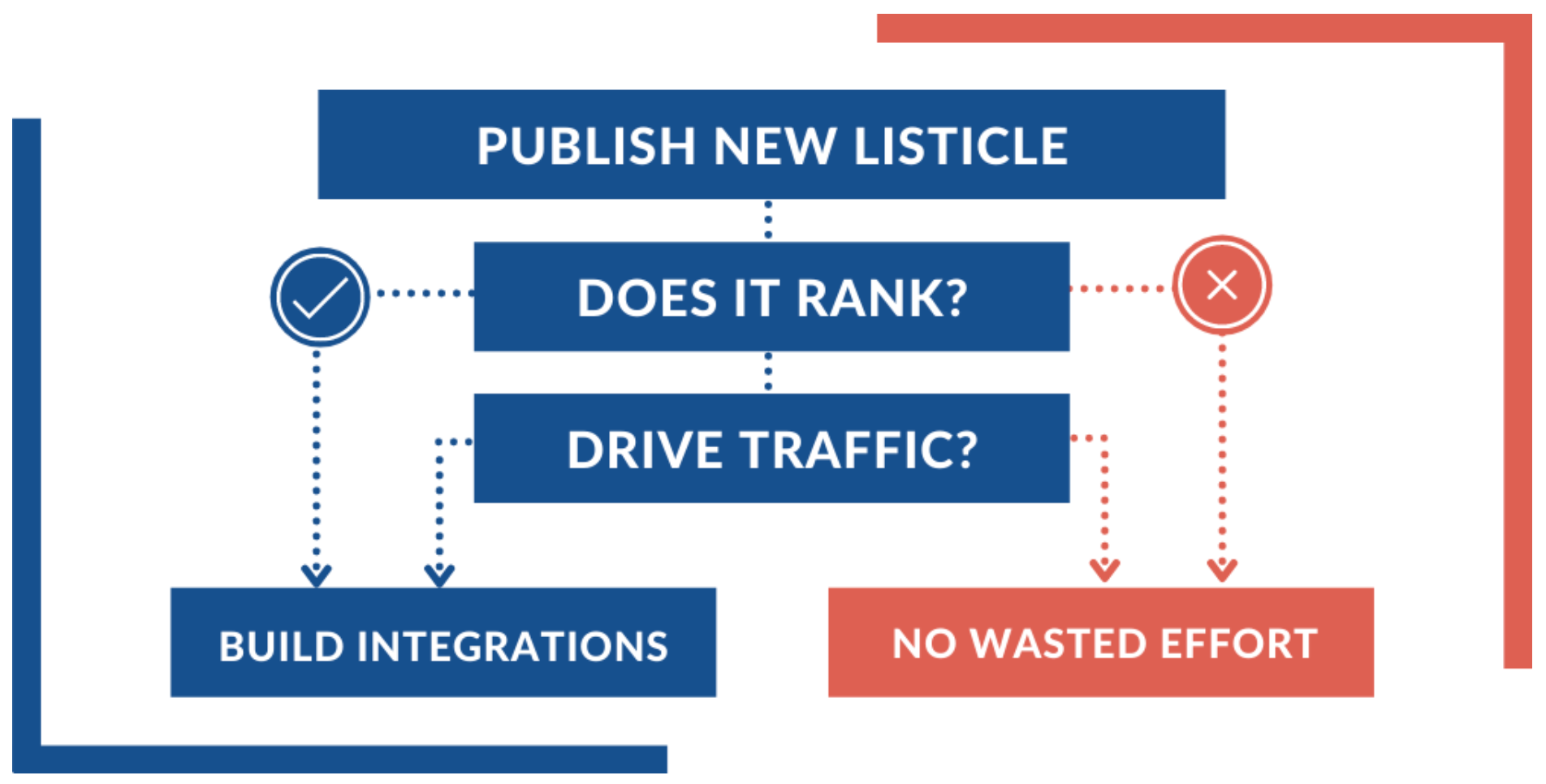
This is a really cheap and effective way to test a product feature, without having to actually build that feature!
And, if they decide to build out integrations for those different apps, the listicle is already ranking on top keywords.
They can just insert those integrations directly into the listicle and start driving conversions immediately. I think that is the most brilliant part of this whole operation.
Instead of waiting around for it to rank and then start driving conversions, Zapier already has a listicle ranking on high-volume keywords.
They have effectively by-passed the usual delay between when content is published and when it ranks! It’s genius!
And finally, their expansion team can also use actual metrics to reach out to brands that they want to add to the Zapier platform.
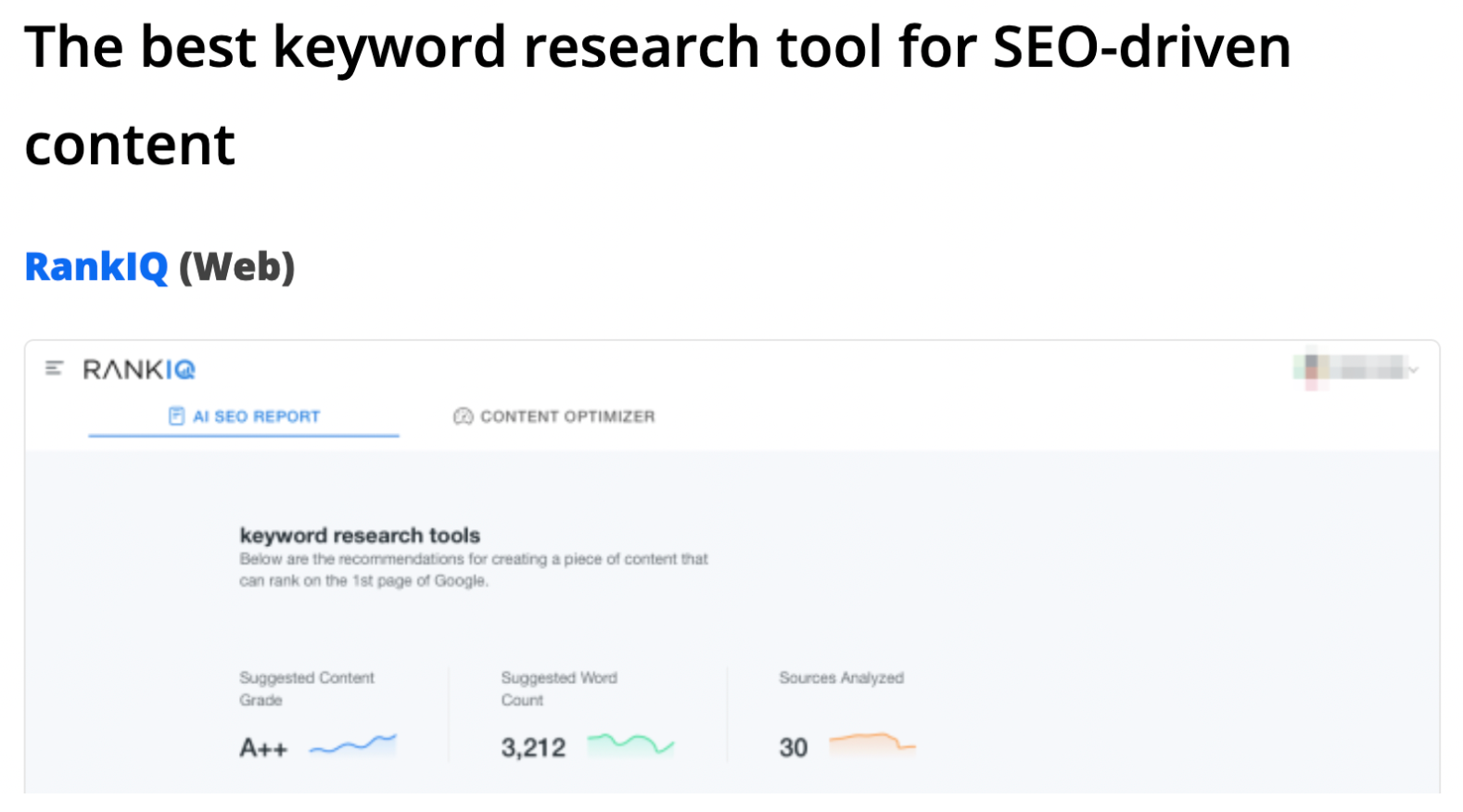
Instead of simply asking a brand like RankIQ to join, they can approach a company with metrics like “132k people viewed this listicle last year.” That’s a pretty compelling case.
So as you can see, these listicles are very important to Zapier’s strategy and can help guide future product decisions as well!
Wrap up
Zapier has built an incredible content moat with the simple listicle.
Listicles have a bad reputation in the eyes of most marketers. They are seen as lazy content that anyone can create, but Zapier has bucked that trend with its “best of “ listicles.
Not only can they use them to target almost any app niche or category, but they can also use them to drive future integrations.
That’s why I think these are not going away anytime soon. They are just too powerful.
The good news is that you can copy their strategy and open up a whole new market or channel with your content! You just have to put in the work and find what works best for your business.
So get to work!
Stay up to date with all of our latest findings by subscribing to our newsletter today. Signing up also gives you early access to Ross’ Tuesday essay full of exclusive industry insights.
Quick, do it now before the next drop!








